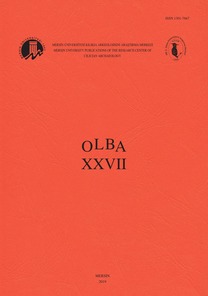Alahan Manastırı. Eski Buluntular – Yeni Yorumlar
Son birkaç yıl Roma ve Erken Bizans eyaletleri Kilikia ve Isauria’ya dair tarihi ve arkeolojik ilginin yeniden canlanmasına tanıklık etmiştir. Kapsamı genişleyen yüzey araştırmaları bu eyaletlerin sınırları, üst yapıları, yerleşmeleri kadar ekonomik ve dini gelişimleri hakkındaki bilgilerimizi arttırmıştır. Yine de özellikle dağlık iç kısımlardaki nispeten az sayıdaki mevcut ve kazılmış kalıntılar bizi bu konular üzerinde varsayımlarda bulunmaya zorlamaktadır. Araştırmaların şu anki durumuna bakarsak çalışmalar için münferit maddi kalıntılara odaklanmak ve bunları yakın tarihli yüzey araştırmaları tarafından çizilen genel resimde bir yerlere yerleştirmek uygun görünmektedir. Bunu yapabilmek için bazı arkeolojik sit alanları ve anıtların yeniden derinlemesine incelenmesinde yarar vardır. Bu makale, Toroslardaki Yukarı Göksu Vadisi’nde, Mut’un 23 km kuzeyinde bulunan Alahan Manastırı’nı ele almaktadır. Silifke’yi Karaman’a bağlayan yolun 200 m yukarısında bulunan Alahan, harika bir konum içinde birçok mimari kalıntıya sahiptir. Bunlar Isauria’daki en ünlü Erken Hıristiyan şehir olması dışında iki önemli özelliğidir. Burası 1955-1972 arasında Michael Gough tarafından kazılmış, fakat kendisi kazıları ve nihai raporu bitiremeden vefat etmiştir. Gough ve ardından gelen birçok bilim adamı Alahan kompleksinin I. Leo (457-474) tarafından başlatılmış ve Isauria’lı kökenleri dolayısıyla kendi memleketine para harcaması çok muhtemel olan halefi Zeno (474-491) tarafından genişletilmiş bir inşa programının parçası olduğunu düşünmüşlerdi. Öte yandan sit alanında imparatorca herhangi bir desteğin verilmemiş olması –mesela ithal mermer kullanımı– ve kalıntılardaki mimari süslemelerin üslup özelliklerine göre 6. yüzyıla tarihlendirilmesi sebebiyle çeşitli itirazlar olmuştur. Bu makale münferit yapıların ya da bunlara ait kısımların rekonstrüksiyonu üzerine geçmiş yıllarda varılmış fikir birliğinden ayrılır. Söz konusu yapılar arasında kompleksin batı ucundaki bazilika, özellikle de doğu kısmı ve çatı örtüsü, şimdiye kadar açık bir alan olduğu düşünülen bir yerdeki sivil mimari ve sözde Doğu Kilisesi olarak bilinen yapıya ait kulenin tartışmalı çatısına ait basitleştirilmiş rekonstrüksiyon bulunmaktadır. Makalenin ikinci bölümü kompleksin yapı silsilesini yeniden ele almakta ve ilki 451-462 arasında diğeri de muhtemelen I. Iustinus (518-527) ya da I. Iustinianus (527-565) döneminde olmak üzere iki inşa evresinin varlığını ortaya koymaktadır. Bu tespiti yapı evreleri arasındaki önemli farkları daha da pekiştirmek üzere maimari süslemelerin karşılaştırmalı bir incelemesi izlemektedir. Çalışmanın son kısmı ise yapı evrelerinin tarihlerini kaynakların imparatorluk ve bölgeyle ilgili verdikleri tarihi olaylarla ilişkilendirerek Zeno’nun saltanatında Yukarı Göksu Vadisi’nin Michael Gough’ın düşündüğü gibi huzurlu bir krallık olmadığını göstermektedir. Makaleden çıkan başlıca sonuçlar Michael Gough’ın Alahan’la ilgili belgelemesinin etraflıca gözden geçirilmesi, mevcut yapıların mimari açıdan yeniden değerlendirilmesi ve Gough’ın zamansız ölümüyle yarım kalan kazıların tekrar başlamasına duyulan ihtiyaçtır
ALAHAN MANASTIR.
ALTE BEFUNDE – NEUE DEUTUNGEN
The past few years have seen a newly increased historical and archaeological interest in the ancient Roman and early Byzantine provinces of Cilicia and Isauria. Extended surveys have helped to widen our knowledge of their territories, infrastructure, and settlements as well as their economical and religious development. Yet still, the comparatively little amount of extant and – even more important – excavated remains, especially in the mountainous hinterland, forces us to hypothesize on these matters to a great extent. Given this state of research it seems appropriate to refocus on single material witnesses to reexamine them and try to locate their position in the overall picture that these recent surveys have drawn. In order to do so some of these archaeological sites and monuments need to be studied in depth again. This article deals with the well-known site of Alahan monastery in the Upper Göksu valley in the Taurus Mountains about 23 km north of Mut. Situated 300 m above the route that links Silifke to Karaman the place is studded with architectural remains in a beautiful setting; two facts that besides the uniqueness of the place account for its reputation as the most famous early Christian site in Isauria. The place has been studied and excavated between 1955 and 1972 by Michael Gough who unfortunately died before he could finish the excavations and the final report. Gough and many scholars after him promoted the idea that the complex of Alahan was part of an imperial building program initiated under the emperor Leo I. (457- 474) and extended under his successor Zeno (474-491) whose Isaurian descent made him likely to have spent great amounts of money on his home province. On the other hand, it has been argued that the site shows no traces of imperial patronage, e.g. the use of imported marbles, and that the architectural decoration of the remains should rather be dated to the sixth century based on stylistic grounds. In this article it is proposed that the reconstruction of single buildings or parts of them differs from what has been the consensus in the past years. These include the basilica at the western end of the complex particularly the eastern part of the building and its roofing, a secular building in a spot that was up to now thought to be an open space, and a simplified reconstruction of the much discussed roof above the central tower that crowns the so-called East Church. The second part of the article reexamines the building sequences of the complex and develops a scenario of two building sequences, the first taking place between 451 and 462 and second probably under the reign of either Justin I. (518-527) or Justinian I. (527-565). This is followed by a comparative analysis of the architectural decoration to further establish the significant differences between the building sequences and allow for a more precise dating of them. The last part of this study attempts to fit the dates of the building sequences to the historical events that the sources report for the empire and the region of Isauria trying to show that at the time of the emperor Zeno the Upper Göksu valley was not the ›peaceful kingdom‹ Michael Gough had thought it to be. The foremost conclusions to be drawn from the ideas presented in this article are the need for a thorough review of Michael Goughs documentation of his work at Alahan, a new architectural analysis of the extant buildings, and the initiation of new excavations that pick up where the untimely death of Michael Gough had stopped them.
